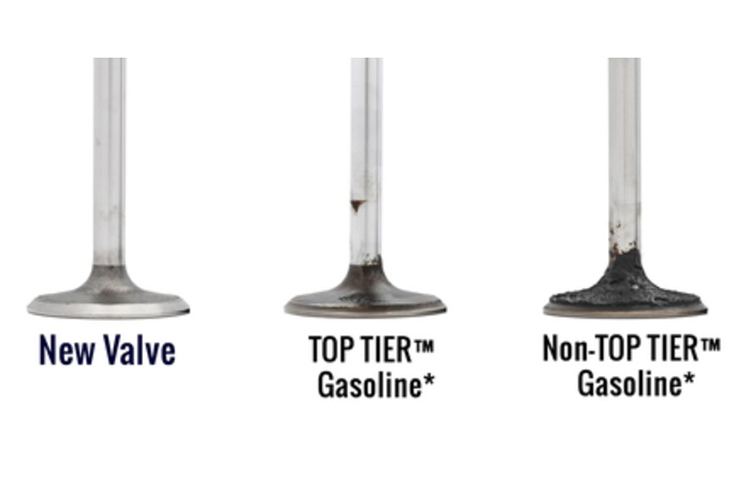Some of the best ways to help enhance fuel economy are through proper maintenance and good driving habits. For example, replacing the engine air filter at the recommended maintenance intervals, maintaining the correct tire inflation pressures and removing any extra equipment from the vehicle, such as bike racks, can help in reducing fuel consumption. At the same time, driving less aggressively and anticipating stops can also help. (Fig. 1)
 Fig. 1
Fig. 1
There are other items that customers should consider as well to optimize their vehicle’s fuel economy. Here are a few things to share with customers regarding optimizing vehicle performance.
TOP TIERTM Gasoline
Properly maintained engines can provide optimal fuel economy and performance. TOP TIER gasoline was developed in 2004 when a group of automakers, including General Motors, BMW, Honda, Toyota, Volkswagen, Audi and Mercedes-Benz, recognized the need for a higher detergency gasoline than that required by U.S. regulations. TOP TIER Detergent Gasoline is the premier standard for gasoline performance with a higher detergency standard than the U.S. Environmental Protection Agency (EPA) and Canadian General Standards Board (CGSB) minimum requirement. The added detergents can result in a lower amount of intake valve deposits that can negatively affect fuel economy, emissions, and performance. (Fig. 2)
 Fig. 2
Fig. 2
Avoid lower quality gasoline that can leave deposits on critical engine parts, reducing engine performance. TOP TIER fuels are preferable when and where available. Many fueling stations selling TOP TIER licensed brands prominently display the TOP TIER logo on the pump, pump handle, canopy or in a station window. (Fig. 3)
TIP: The TOP TIER fuel designation should not be confused with higher octane (plus/premium grade fuel) commonly sold at most gas stations. Plus and premium fuels are required in some GM high-performance vehicles. However, they do not necessarily represent the higher detergency that is present in available TOP TIER Detergent Gasolines. For high-performance vehicles that require premium fuel (91 octane or higher), fuels of at least this octane must be used. Using lower octane fuel may result in reduced performance, knocking, and/or permanent engine damage that is not covered under the terms of the New Vehicle Limited Warranty. Using higher octane fuels in a vehicle that only requires regular unleaded fuel will not increase performance or improve gas mileage. Only use the octane-rated fuel recommended as specified in the vehicle’s Owner’s Manual.
Additional gasoline brands are added to the TOP TIER list as they meet the standards. For a list of TOP TIER Detergent Gasoline retailers, visit toptiergas.com.
 Fig. 3
Fig. 3
Alternate Fuels
A recent idea to improve fuel economy is to blend either kerosene or diesel fuel into gasoline. Both kerosene and diesel fuel are distillate fuels meant for use in compression ignition engines, not spark ignition engines. They have very low octane and, since they are heavier (higher density) than gasoline, they will cause heavy engine deposits, degradation of engine oil and very poor drivability. If kerosene or diesel fuel is put into a gasoline engine vehicle, any performance conditions, drivability concerns or damage to the engine will not be covered by the New Vehicle Limited Warranty.
Fuel Injector Cleaning
Fuel injector cleaning is recommended only when performed as directed in Service Information diagnostic procedures. However, to address the variation in fuel quality in different areas of the country, the only preventative maintenance currently endorsed by GM regarding its gasoline engine fuel systems is the use of GM Fuel System Treatment PLUS added to a tank of fuel at each oil change. The fuel additive is to help with the prevention and removal of deposits from spark-ignited engines, particularly from the intake valves, fuel injectors, and the combustion chamber.
Driving Habits
Many driving habits as well as driving conditions affect fuel consumption, such as aggressive driving, altitude, ambient temperature and traffic.
While driving, slow down and drive smoothly. Efficient driving includes avoiding quick/full-throttle acceleration from a standstill at stop lights and high cruising speeds on the interstates. While the optimum MPG or L/100 km for highway cruising speed varies from vehicle to vehicle, faster is almost always worse. If the vehicle is equipped with a Driver Information Center that displays Instant Fuel Economy, select that display and vary the vehicle’s cruising speed while on the highway. The display will change continuously with uphill and downhill sections but you should quickly be able to identify on level ground the speed range that the vehicle performs best in.
In addition, before a trip, avoid extended idling when starting the vehicle. There is no need to idle the engine until it reaches full operating temperature. Extended idling time wastes fuel and has a negative impact on fuel economy. When using the Remote Start feature (if equipped), keep the idling time to a minimum. Starting the car on a very cold day and leaving immediately may actually cause the engine to consume more gas. Warming it up and thinning the oil for a few minutes can actually help improve mileage.
For additional information, refer to the latest version of Bulletin #05-00-89-072.
– Thanks to Steve Bruder


















